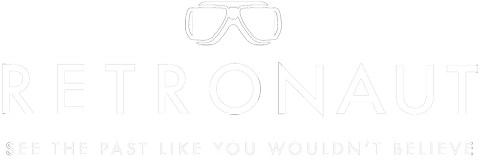How digital history lessons can ‘disrupt’ the way we think about time
Retronaut.com’s founder says its success comes from super-high-resolution historical images which shock viewers into reconsidering the present day.
- Brian Lufkin
Ever since he was a kid watching Doctor Who, Wolfgang Wild had the burning desire to travel back in time. Today, the 43-year-old English museum curator is webmaster of Retronaut.com, a site leading the Internet’s recent obsession for finding, sharing, tweeting, and pinning historic images.
What makes Retronaut different? Its images are relatively obscure, carefully gathered from museums and archives, and are what Wolfgang Wild dubs ‘disruptive’.
“As you know, ‘disruptive’ is a big word among startups,” he says. Wild credits disruption to Retronaut’s success. He’s talking about disruption in a temporal sense–meaning, the images on his site are specifically chosen to make the viewer feel like they’re looking not at the past, but rather at a different version of the present.
The example he points to is the most popular image on Retronaut, and the first post on the site to go viral, which happened back in 2010: 1949 photos of London’s Piccadilly Circus in full color. Instead of seeing grainy black and white, viewers see the crisp, colorful streets of one of England’s most bustling and most famous intersections, with the quality of how it’d look in person. It’s not just a vignette from a distant decade.
Wild says the high quality makes it a “different version of now”. Technology, according to Wild, will permanently alter the way we think about time and trends–and that’s Retronaut’s core mission.
“In the next few decades, our notion of history will change,” Wild says. “Prior to the Internet and widespread digital technology, history was analog, and becomes less and less granular the further back we go. Most of those pictures are in black and white, and the pictures become fewer and fewer.
“History becomes something that is ghostly and old and sepia and dusty–that’s never going to be the case again. From this point, we will have an almost immaculate recording of everything. Google Street View is updated all the time, for example. It won’t be something we can ever notice, because it’ll just be the case.”
Other examples from the site that evoke a remixed version of the past include color photos of the Hindenburg’s interior (because Wild says you rarely see images inside any zeppelin, let alone ones in recognisable color), photos of Afghani female scientists in the 1950s (women in laboratories suit 2014, but it’s a jolt to see such progressive photos in a country that Westerners deem challenging for women), and hi-res color photos of World War II-era Manhattan (the 70-year-old images could’ve been taken with a digital camera).
“I use Pinterest and Reddit all the time,” Wild says. “Retronaut works very well as a viral post site, so it’s got a BuzzFeed element to it. It’s the very visual sort of stuff you’re likely to share on your lunch break, so it’s got that superficiality about it, which I like.”
St. Paul’s Chapel, Manhattan (Library of Congress)
The images that make it on to Retronaut all must have that disorienting, disruptive quality. That’s made his site so successful, with its over 200,000 Facebook fans. Wild recalls a recent trip to New York City, in which he meandered down to Battery Park.
As he stood near Ground Zero, he unwittingly found himself near St. Paul’s Chapel, Manhattan’s oldest church and where George Washington supposedly attended service on his inauguration day.
Wild noticed the weathered headstones outside. One of the still-legible epitaphs read: The wife of William Holly, who departed this life 1785, aged 26 years and 9 months.
“That stone hasn’t moved,” Wild said. “She was once living in this small, rural town that was once Manhattan, and her headstone is still there,” in what’s now America’s financial hub. “That’s what I mean by ‘disruptive,’” Wild says – it literally rocks your brain out of its complacency.
That psychological disruption has landed him a book partnership with National Geographic who will publish his 350-page, image-filled book, Retronaut: The Photographic Time Machine, showcasing some of the website’s greatest hits.
So how does Wild assemble his collection? It’s actually quite easy–provided you’ve got years of experience working in museums, which Wild does. The site’s content stretches a span from prehistory (cave paintings) to the Dark Ages to the present day, and he works closely with cultural institutions who supply the choicest images. In addition, he’s digital curator of Europeana, the gargantuan archive of more than 30 million historical items supplied by 2,300 of Europe’s galleries, libraries, and museums.
Wild curates a capsule a day for their website, and in doing so, created the most-viewed image on Europeana’s website (a very small child standing next to a very large pig), as well as the most-searched term (‘plastic surgery,’ particularly nose jobs in the 1930s), of last year. “For our children, their notion of ‘history’ will be very different than ours,” says Wild.


